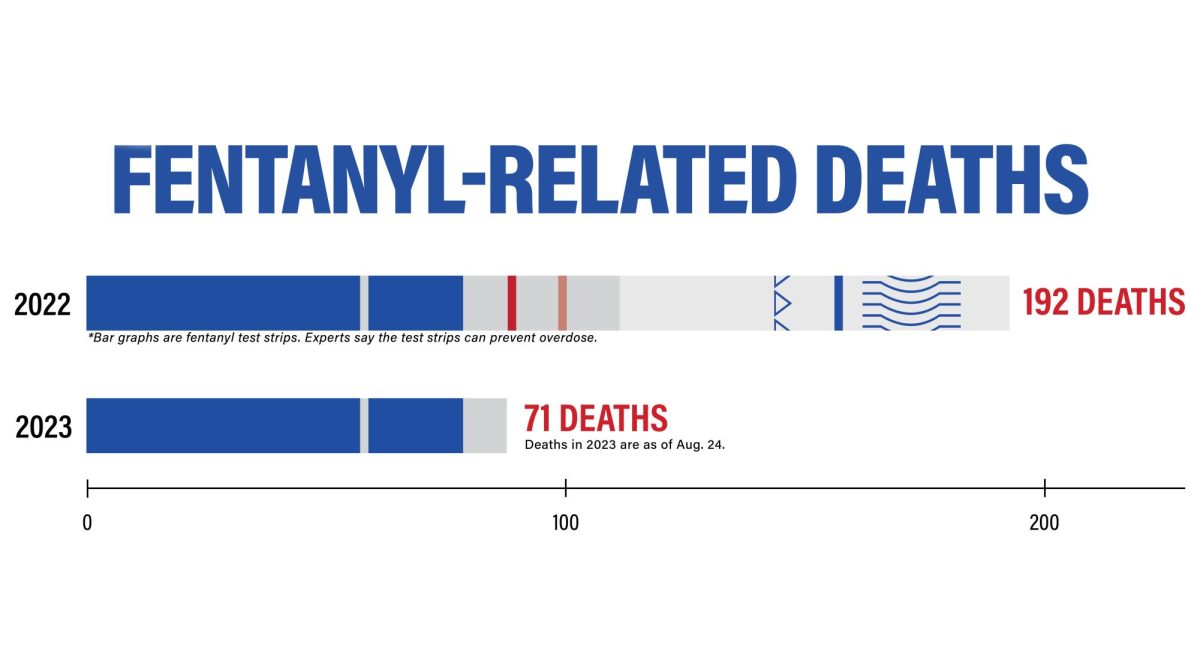Lisa Bortz lost her daughter, Jillian, to a fentanyl overdose in 2022. Instead of celebrating Jillian’s 33rd birthday, Lisa was burying her.
“She tried, she really did try. She had three kids at a very young age,” Lisa said. “She just struggled real hard.”
Jillian was in and out of recovery from substances for years. During periods of time when she wasn’t using, Jillian helped others through the Oxford House, a house for people recovering from addiction. To assist those in need, she organized a case worker, bail bondsman — whatever was needed to help. But Jillian continued to struggle with her own addiction.
“Then she would trigger, and she would fall,” Lisa said. “The cycle would repeat itself – until fentanyl came along.”
Lisa said it only took about three months for fentanyl to change her daughter into a different person.
“She was just so desperate. We fought so hard the last three months of her life, and it was because of fentanyl,” Lisa said.
After her daughter’s death, Lisa went through Jillian’s text messages. The night she died, Jillian thought she was getting heroin. If this were the case, Lisa believes her daughter would still be alive.
“Her autopsy had absolutely no heroin, no cocaine, no marijuana, no alcohol — it was 100% fentanyl,” she said.
Lisa now advocates and supports others in need. She routinely makes hot meals and hands them out to the unhoused community while also offering naloxone and fentanyl testing strips. She has built trusting relationships with certain people, and because of the resources she offers, she said she has heard fewer reports of overdoses within the unhoused community.
Harm reduction 101: Meeting people where they’re at
Safe Streets is a coalition in Wichita that is dedicated to substance misuse prevention through evidence-based research, advocacy and working with local government leaders to update drug policy. Lisa is a member of this coalition, as is Ngoc Vuong, a graduate teaching and research assistant in psychology at Wichita State.
Previously the community mobilizer and project manager, Vuong currently volunteers at Safe Streets and authored a report about harm reduction and preventing opioid deaths in Kansas, which was published in July 2021.
Harm reduction emphasizes meeting people where they’re at. It focuses on mitigating the harm that substance use can cause, rather than relying on pushes to “just say no” and abstinence as the best policy for everyone.
Five main strategies mentioned in the report include improving naloxone access, decriminalizing fentanyl test strips, syringe services programs (SSPs), 911 Good Samaritan Law, and improving access to medication for those with opioid use disorders. Since the report was published, fentanyl test strips have been decriminalized.
Safe Streets works to make opioid medications and SSPs more accessible. Methadone, a medication for opioid addiction, helps with symptoms of withdrawal and drug cravings; buprenorphine and naltrexone can also help.
There are some misconceptions that people are simply swapping one drug for another when using methadone or other medications for treatment. Because of this, these medications are not always readily available. To prescribe buprenorphine, doctors need training in addiction recovery or must undergo an extra eight hours of training.
Medication for opioid addiction is also expensive. According to The National Institute on Drug Abuse, methadone treatment costs $6,552 per year, buprenorphine treatment is $5,980 per year, and naltrexone is $14,112 per year. These prices include the costs for opioid treatments for medication and at least weekly psychosocial treatments.
According to Vuong, Safe Streets has made opioid medication more available by encouraging pharmacists to sign up to become naloxone dispensers, encouraging public schools, public libraries, firefighters and law enforcement to carry naloxone, and distributing fentanyl test strips.
As of Aug. 4, Safe Streets has distributed 6,361 naloxone kits and 5,417 fentanyl test strips from January to August 2023. 446 naloxone kits and 373 fentanyl test strips were reported to have been used.
“We realize that governments and communities are delayed or complacent in addressing the opioid epidemic — people’s lives are at stake,” Vuong said. “And people have died as a result of ineffective drug policy.”
Lisa and Vuong, along with others within Safe Streets, aim to have a positive impact in the community through harm reduction.
Harm Reduction 102: Offering respect and compassion
Harm reduction researchers categorize addiction as a public health concern rather than a criminal justice issue or one’s inability to choose not to do drugs. There are many reasons a person might use drugs, including but not limited to coping with traumatic events and awful childhoods, pain relief from a medical condition, or mental illnesses when the mental health system has failed them.
According to Harvard Medical School, a stressful and traumatic environment also inflicts epigenetic changes — it affects how one’s genes are expressed — and can trigger the development of addiction or a relapse in recovery.
Vuong’s report states that harm reduction practices require offering dignity, respect and compassion to make positive changes in how substance use is dealt with.
“Acceptance that people who use substances are entitled to basic human rights and services are tantamount to harm reduction,” Vuong wrote in his report.
How to help
Every day, 150 people die nationwide from opioid-related overdoses — many of which are caused by fentanyl. In Sedgwick County, there were 192 fentanyl-related deaths in 2022, and as of Aug. 24, there have been 71 fentanyl-related deaths in 2023.
Pharmaceutical fentanyl is prescribed by doctors as a powerful pain reliever while illegally-made fentanyl is marketed for its effects similar to heroin. According to the CDC, fentanyl is 50 times stronger than heroin and 100 times stronger than morphine. It is cheap and easy to make, and because of its potency, it can be easily added into other drugs without one noticing.
The signs of overdose include pinpoint pupils, clammy skin, discolored lips and skin, a limp body and choking sounds.
If you come across someone overdosing, using naloxone can quickly reverse it. It works by attaching to opioid receptors in the brain to block the effects of opioids. Multiple doses of naloxone may be necessary.
If you’re not sure if someone is overdosing on an opioid, but they display possible signs, it is still best to use naloxone, as it is not harmful to administer even without an overdose.
Kansas residents can get free naloxone and fentanyl test strips sent to them by filling out the Naloxone Kit Request Form on DCCCA’s website.
For recovery help, call the free and confidential treatment referral hotline (1-800-662-HELP), or visit findtreatmnet.gov. KMUW also provides local resources, which can be found at kmuw.org/substanceuse.





